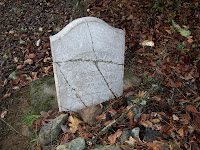
The final resting place of a 40 year old man who died along the Applegate Trail in 1867 near what is now Merlin, Oregon.
Between the 1830's and the 1870's, roughly 200,000 people migrated from the Eastern portion of the United States to the Western coast of North America along what is popularly known as the Oregon Trail. Officially, the trail extended over 2000 miles across a mostly unpopulated and very wild continent, typically starting at Independence, Missouri and usually ending at Oregon City in Oregon's fertile Willamette Valley. The average journey took four months and was filled with extreme hardship. Contrary to popular myth, many of these people actually turned back toward their homes and never did make it out West.
Along the trail, over 25,000 of these immigrants (they didn't call themselves "Pioneers") died from various causes and it has been estimated that there is an average of one grave along every eighty feet of the trail. Though most of these graves were unmarked and their locations long since forgotten, a large number of markers can still be found along the trail.
Contrary to the popular misconception, the Oregon Trail isn't actually a single trail. Though Independence, Missouri was the popular gathering spot to asemble wagon trains, the trail actually began wherever the immigrants originated. (I use the term "immigrants" simply because the people involved used that same term for they were actually leaving the United States and moving to a new country, which early on was actually under European rule). Much the same way, though the official end of the trail was originally Oregon City, the journey ended wherever a family chose to settle. Though many did go to the Willamette Valley, many others went on to California or what became Washington (then called Columbia). Quite a few actually settled in British Columbia which is now part of Canada. Those who chose to go on to the Pacific North West essentially stayed on the Oregon Trail, while those who chose to go to California, took a branch in the trail in Western Idaho that went south west. (Here in Oregon, we have an old legend about where the trail splits in that the northern spur of the trail was marked by a sign which read "To Oregon", while the southern branch was marked by a pile of pyrite (Fool's Gold) and marked the way to California. People who could read took the northern branch, while people who were greedy and illiterate went to California. Some Californians like to claim that it was really the other way around.) As well, in addition to these two main branches, some parties also made their own way. One such group were the Applegate Brothers who migrated to the Willamette Valley in 1843, yet lost three family members while floating the Columbia River near the Dalles. By the Spring of 1846, the three brothers were determined to find a safer route to the Willamette Valley and soon established the Applegate Trail which cuts off of the California Trail in Western Nevada and then meanders through Southern Oregon toward the Willamette. In 1853, over 3500 people used this route, which today runs the same route as Nevada State Highway 66 and Interstate 5.
Contrary to what you may have learned in history class at school or have seen in movies, these people did not come over the Plains in Constega Wagons pulled by mules or horses. Constega Wagons were actually much too heavy to make the journey, while horses and mules were not only too expensive and difficult to keep in condition during the journey, but they also proved very tempting to Indians who had a fondness for stealing them. Instead, they used much lighter wagons which were pulled by six oxen.
As well, nobody actually rode in the wagons, either. In addition to there not being enough space for riders (too many provisions in the wagon), the wagons actually didn't have a seat for a driver. (Instead of drivers and reins on a harness, they had bullwhackers which moved the oxen along with the aid of a huge bullwhip. Contrary to popular misconception, bullwhackers don't actually whip the oxen either. Instead the bullwhip has a little "popper" at the tip which when used properly makes a great snapping sound through the air to move the animals along). In otherwords, everyone walked 2000 miles to come to Oregon.
Though I mentioned that horses were not used on the trail because they appealed too much to Indians who saw horse theft as a great personal challenge, contrary to all those movies you've seen, most wagon trains never had any problems by Indians. In most movies about the Oregon Trail, you see the wagons placed in a circle to guard against Indian attack while the people camp inside the circled wagons. Though they did place the wagons in a circle, the people actually camped outside of the circle and they actually used the wagons to form a corral for their animals by chaining the tongues of each wagon to the axle of another so that it was secure.
Contrary to the movies, of the 25,000+ people who died along the trail, only about 400 of them were killed by Indians and for the most part, many wagon trains were assisted by Indians. Most of the old fashioned herbal cures that pioneer women knew were actually learnt from Indians that these women often met along the trail to Oregon.
Although the establishment of the intercontinental railroad largely spelled the end of the Oregon Trail by the 1870's, the trail actually remained in use by migrants using covered wagons as late as 1912.
Kind of makes you wonder what else they didn't tell you in school, doesn't it?




No comments:
Post a Comment